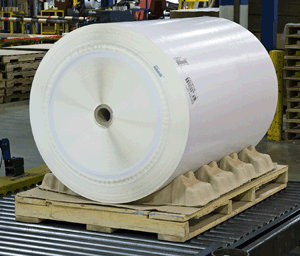Riding the Rails
- Published: April 01, 2010, By Edited by Claudia Hine, Managing Editor
When it comes to shipping materials, product needs to arrive undamaged. That was the challenge faced by the Coated Products Operations of Green Bay Packaging, which ships rolls of its pressure-sensitive label material from Green Bay, WI, to Mexico, Canada, and across the US.
Utilizing rail for shipments makes sense economically, but the jolting starts and side-to-side rocking motion of boxcars sometimes caused wood wedges to loosen from pallets, allowing rolls to move against the metal banding used to secure them.
The large rolls, which measure 52-60 in. long, sometimes sustained heavy damage from friction with the metal banding. The rocking movement also put pressure on a customized honeycombed wedge product, causing it to fail. “When the train would rock back and forth, sometimes it would cause the rolls to crush the corrugated wedges, allowing the load to shift off the pallet or tilt,” says slitter/shipping superintendent Jeff Klima.
“We knew we had to do something quickly,” says Todd Keckhaver, scheduling and planning manager. “There were times when the entire load had shifted and sustained some sort of damage.” The solution was literally in-house.

“I saw some incoming material from one of our suppliers packaged in a way I thought could work for our large rolls,” says Keckhaver. “It was a fiber roll cradle from Rollguard.”
Rollguard brought in samples of its full-roll RF-40-FRS cradle product, which were used right away to ship a couple of rolls. “Everything shipped just fine from the very first time,” says Keckhaver.
That first test shipment was conducted in November 2005. Today, after shipping 4,000-5,000 rolls per year using the roll cradles, there has been zero product damage, says Klima. “It's been fantastic. We have not a single report of damaged product.”
Recycled & Reused
The full-roll-support cradle is made from recycled corrugated molded pulp. The density of the molded pulp reportedly has less dusting compared to similar cradles made from honeycomb material.
For Green Bay Packaging, all that's necessary is to set the Rollguard cradle on the pallet and place the roll in the cradle. Next, two bands are placed across the roll lengthwise to secure the roll and the cradle to the pallet. Because plastic bands are used, no band padding is required.
As a final step, stretch wrap is applied to the entire pallet to protect the outer layers of the label material and further unitize the load.
The previous method of palletizing was more labor intensive, requiring the nailing of wood wedges to the pallets. This also posed problems after shipment because the pallets had to be disassembled. In some cases this damaged the pallets, which resulted in disposal and repair issues. There also was the added hurdle of making sure all the wood that was used was kiln dried to ensure it was bug-free in order to ship into Mexico.
“The way it works now is perfect,” Keckhaver said. “We just take the cradle off and reuse the pallet. We often ship material to our other facilities for converting. When the product is returned here to Green Bay, the other plants actually send the cradles back. So we've been able to reuse them. That's enabled us to get additional turns out of them, which has been an added benefit.”
Supplier Info
Rollguard | www.rollguard.com Circle 305 or visit www.freeproductinfo.net/pff
Converter Info
Green Bay Packaging, Coated Products Operations | 3250 S. Ridge Rd., Green Bay, WI 54307 | 800-445-4269 | www.gbp.com




